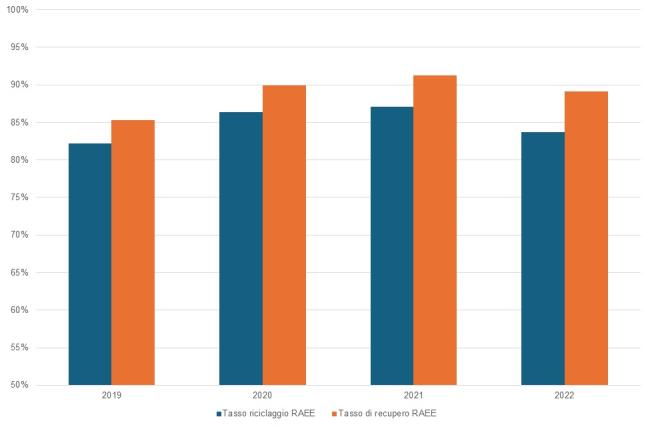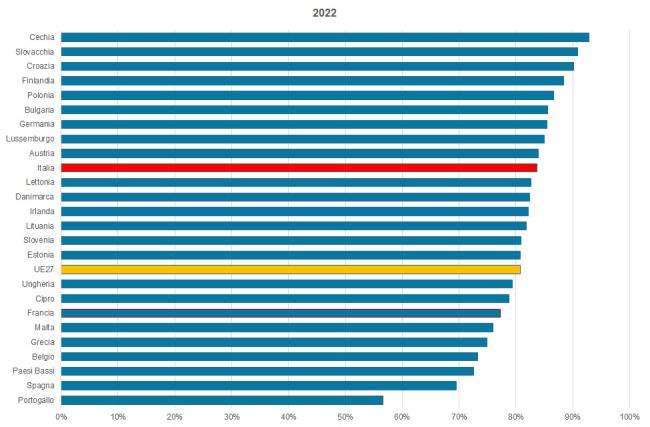Panel 1
Costanza Mariotta, Jessica Tuscano
Driven by EU policies, the management of Waste Electrical and Electronic Equipment (WEEE) has become a key aspect of waste management within the circular economy framework, especially concerning the supply of Critical Raw Materials. Unlike general waste, WEEE contains both hazardous substances and valuable materials. Legislative measures aim to protect the environment and human health by preventing or reducing negative impacts from the design, production, and disposal of electrical and electronic equipment.
The recycling industry plays a crucial role in the transition to a circular economy, enabling the reintegration of recovered materials into production cycles, improving resource efficiency, promoting sustainable development, and reducing the need for raw material imports. In 2022, the total collected WEEE amounted to approximately 534,000 tonnes, with a preparation for reuse and recycling rate of 83.7% and an overall recovery rate of 89.1%.
The indicator quantifies the ratio between the amounts of waste from electrical and electronic equipment (WEEE) that are recycled, including those prepared for reuse through processes such as inspection, cleaning, disassembly, and repair, relative to the total amount of waste collected, encompassing both household and professional sources. Household WEEE originates from domestic units and also includes items from commercial, industrial, institutional, and other sectors that are analogous, in nature and quantity, to those generated by households; professional WEEE refers to all waste not originating from household sources. Electrical and electronic equipment encompasses a broad spectrum of devices, including mobile phones, computers, televisions, refrigerators, household appliances, lamps, as well as medical devices and photovoltaic panels. With the continuous market expansion and increasingly shorter product life cycles that render devices obsolete after only a few months, these products are replaced at an accelerating rate, thereby contributing to the quantitative growth of WEEE. Moreover, modern electronics contain both hazardous substances and materials of significant economic value, as well as critical raw materials, which are vital for various industrial sectors. Improper management of these waste streams can lead to adverse impacts on human health and the environment, as well as economic repercussions. Conversely, ensuring the effective closure of the value chain through a comprehensive, efficient, and homogeneous collection system across the national territory, coupled with appropriate treatment of WEEE that facilitates the reintegration of recycled materials into production cycles, can enhance resource efficiency, facilitate the transition to a circular economy, and contribute to the supply of critical raw materials.
Monitoring progress towards a circular economy in the thematic area of "waste management" is essential. The circular economy is based on resource optimization, achievable through eco-design strategies that ensure increased product durability, reusability, potential for upgrading, and repairability, greater use of recycled materials, and enhanced recyclability at the end of life, thus reducing environmental impacts and the volume of waste generated. Electrical and electronic equipment encompasses a wide range of devices, including mobile phones, computers, televisions, refrigerators, household appliances, lamps, as well as medical devices and photovoltaic panels. With the continuous market expansion and shortening innovation cycles, which render equipment obsolete in just a few months, these devices are being replaced more rapidly, contributing to a quantitative increase in the flow of WEEE. Moreover, modern electronics contain both hazardous substances and materials of high economic value, as well as critical raw materials that are strategic for numerous industrial sectors. Improper management of such waste can therefore result in adverse impacts on human health and the environment, as well as economic repercussions. Conversely, ensuring the closure of the value chain through a homogeneous, widespread, and efficient collection network across the national territory, and providing appropriate treatment of WEEE that enables the reintegration of recycled materials into production cycles, can enhance resource efficiency, support the transition to a circular economy, and contribute to the supply of critical raw materials.
Directive 2008/98/EC of the European Parliament and of the Council of November 19, 2008, on waste.
Directive 2012/19/EU of the European Parliament and of the Council of July 4, 2012, on waste electrical and electronic equipment (WEEE).
Legislative Decree No. 152 of April 3, 2006, Environmental Regulations.
Legislative Decree No. 49 of March 14, 2014, Implementation of Directive 2012/19/EU on waste electrical and electronic equipment (WEEE), which establishes measures and procedures aimed at protecting the environment and human health: a) by preventing or reducing negative impacts resulting from the design and production of electrical and electronic equipment and from the production and management of waste electrical and electronic equipment; b) by reducing negative impacts and improving resource efficiency to achieve sustainable development goals.
Implementing Regulation (EU) 2017/699 of the Commission, of April 18, 2017, which defines a common methodology for calculating the weight of electrical and electronic equipment (EEE) placed on the market in each Member State and a common methodology for calculating the weight of waste electrical and electronic equipment (WEEE) produced in each Member State.
Commission Implementing Decision 2019/2193 of December 17, 2019, which establishes the procedures for the calculation, verification, and reporting of data, and defines the formats for data submission for the purposes of Directive 2012/19/EU of the European Parliament and of the Council on waste electrical and electronic equipment (WEEE).
Panel 2
Data quality assessment
ISPRA (Higher Institute for Environmental Protection and Research)
Utilizzate le informazioni contenute nella banca dati delle dichiarazioni ambientali annuali (MUD) effettuate dai soggetti obbligati ai sensi della legislazione vigente, non accessibili al pubblico.
National
2019-2022
Indicator assessment
The indicator is expressed as a percentage and is obtained from the ratio between the quantity of WEEE (waste electrical and electronic equipment) recycled or recovered and the total quantity of WEEE collected, both from domestic and professional sources. The indicator includes both hazardous and non-hazardous waste.
The amount of WEEE recycled, including those subject to preparation for reuse operations, is calculated as the quantity of waste sent for recycling operations in treatment plants located within the national territory, plus the quantity of waste exported for recycling operations abroad, excluding waste imported from abroad and recycled in domestic plants. Recovered waste also includes those destined for energy recovery operations.
The information base consists of the environmental declarations (MUD) submitted annually by the obligated entities pursuant to Article 189 of Legislative Decree No. 152/2006.
In 2022, approximately 83.7% of the collected waste was either recycled or prepared for reuse through operations such as inspection, cleaning, disassembly, and repair. The total quantity of WEEE (Waste Electrical and Electronic Equipment) recovered accounted for 89.1% (Table 1). At the European level, Italy ranks tenth among countries, with a value 3 percentage points higher than the European average (80.7%, Figure 3).
The indicator can be considered favorable: over three-quarters of the collected waste directed to treatment undergoes recycling processes.
The trend in the recycling rate over the 2019-2021 period shows a positive development, increasing from 82.2% in 2019 to 87.1% in 2021. In 2022, despite an increase in both the quantities collected and those recycled, the recycling rate stabilizes at 83.7%. This change in trend is correlated with a more substantial increase in the quantities collected compared to 2021 (+6.3%), whereas the increase in recycled quantities was more limited (+2.2%).
However, it is important to highlight that further efforts are required to enhance the collection of WEEE, which in 2022 still accounted for only 28% of the amount placed on the market (Table 1).
Data
Table 1: Quantity of EEE placed on the market, and WEEE collected, treated, recovered, and recycled
ISPRA



WEEE (Waste Electrical and Electronic Equipment) represent a key waste stream under monitoring, owing to the intrinsic characteristics of the products from which they derive. These products contain both hazardous substances, which necessitate specific management measures during post-consumer handling, and materials of high economic value, which can be reintegrated into production cycles, contributing to the supply of Critical Raw Materials. The volume of electrical and electronic equipment placed on the market continues to increase, with an estimated 1.9 million tons in 2022, reflecting a 33.8% increase compared to 2019.
Collection remains limited, representing only 28.1% of the total market input, equating to 534,000 tons (+15.7% compared to 2019, Table 1 and Figure 1). Of the WEEE collected, 83.7%—approximately 447,000 tons (+17.8% compared to 2019)—underwent recycling processes, including those involving preparation for reuse through inspection, cleaning, disassembly, and repair. The treatment is primarily conducted in domestic facilities, with the amount of WEEE exported for recycling reaching just over 8,000 tons. Total recovery, which includes energy recovery, accounts for 89.1% of the WEEE collected, amounting to 476,000 tons (Table 1 and Figure 2).